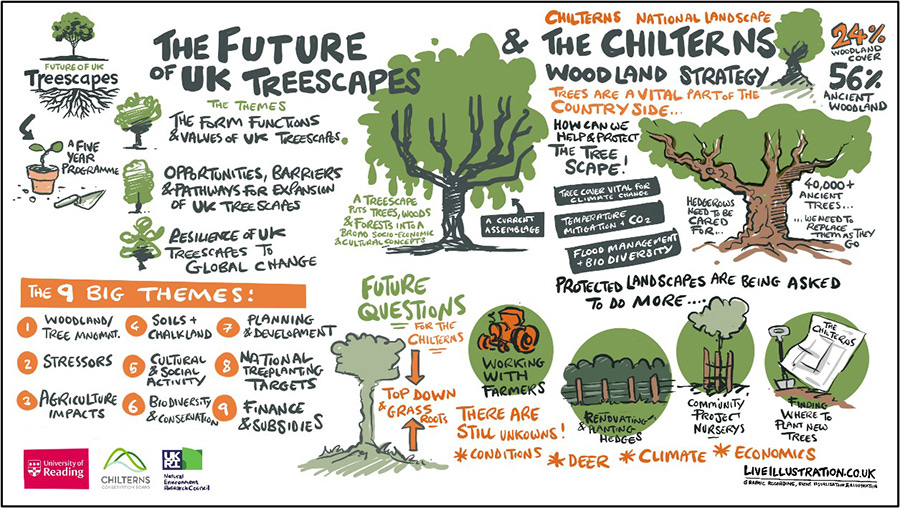The UK Treescapes programme brings together wide-ranging groups and disciplines to explore the environmental, social, economic and cultural roles of the UK’s trees, woodlands and forests. The knowledge gained through the project and research work aims to help guide decisions on how to increase and improve protections for trees and wooded areas to benefit climate, nature and people.
What is a treescape?
“A 'treescape' is a landscape containing woody features, which have ecological functions similar to woodlands. They include natural woodland, managed forests, trees outside of woodland and woody linear features.” (Connected Treescapes | UK Centre for Ecology & Hydrology)
The Future Treescapes in National Landscapes project (2023-24), a collaboration between the University of Reading and the Chilterns National Landscape, explored the knowledge needs of National Landscapes in relation to trees and treescapes.
Why National Landscapes?
National Landscapes (formerly AONBs) are the UK’s protected landscapes - there are 46 National Landscapes across the country, ranging from the highly wooded Chilterns, to the sandy beaches and rolling dunes of the Northumberland Coast. With targets of increasing tree cover across the UK, National Landscapes were highlighted as areas where tree cover can be increased and trees planted. The Protected Landscapes Targets and Outcomes Framework (PLTOF) includes targets to “increase tree canopy and woodland cover (combined) by 3% of total land area in Protected Landscapes by 2050 (from 2022 baseline)”. Within National Landscapes, this must happen while still maintaining the special character of each landscape, including their particular combination of habitats, species and historical aspects. National Landscapes are required to ensure “the right tree in the right place”.
The Future Treescapes in National Landscapes project explored the knowledge requirements of National Landscapes, starting with the Chilterns, to support the design and implementation of a ‘treescapes strategy’.
A treescapes strategy document would outline a comprehensive tree and woodland approach, as a companion to the mandatory National Landscape Management Plan. Working with the Chilterns National Landscape Conservation Board - and speaking to farmers, land managers, ecologists, rural business owners and managers, and representatives from organisations including the Forestry Commission and the Chilterns Society - we explored the research, information and resources available to support establishing trees and treescapes in the Chilterns. We also assessed where the gaps were, and asked what information organisations and individuals would need to grow and manage their treescapes.
People told us they needed to know:
· what was already in the existing treescapes (what is the current tree and canopy cover?)
· how they could respond to the impact of stressors, such as increased deer numbers, ash dieback and climate change
· how to manage different types of woodland, such as ancient woodland
· the different ways in which treescapes could expand (such as natural regeneration)
· the different ways in which trees could be managed and cared for – would coppicing or pollarding be more effective?
· where trees could be planted, from dense woodland and forest to trees in hedgerows and agroforestry - bringing together livestock and trees.
Historical and cultural treescapes were also considered important. This includes ancient woodland and the cultural impact on National Landscapes of activities such as tourism. There was a strong desire to make treescapes accessible to a wider audience.
Out of this collaboration came the development of the Guidance Hub, hosted on The Tree Council’s website. The aim is to bring together information and resources, with a practical focus, to help those “Growing, Planting, Managing and Monitoring” trees and treescapes, and to support getting “The Right Tree in the Right Place” to maintain the National Landscape’s character.
The resources are sourced from a wide range of groups and organisations, and build on The Tree Council’s existing, extensive range of guidance and information. It aims to be useful for a broad range of audiences; from those working with children in educational settings, to volunteer groups, and experts in tree care and management. There are examples of research with a practical focus, information about management techniques, and resources to help explore the range of benefits trees and woodlands can have on nature and wildlife.
We hope you find the Guidance Hub useful and that it supports you in growing, planting, managing and monitoring your trees and woodlands, wherever they are!
Katherine Clark is a Post-doctoral Research Fellow in the School of Agriculture, Policy and Development at the University of Reading.
This project was funded by NERC (UKRI) under the Future of UK Treescapes Programme (Grant Reference: NE/Y004191/1).
MORE: Connected Treescapes by Charlotte Benham










I grow mainly oak trees, creating a new forested landscape connecting blocks of older forest . We are in the process of planning to plant more trees out in a further 12 acres where we are removing rhododendron. I have grown my oaks from acorns I have collected from ancient oak trees around where I live. This project might be of interest to you and I certainly am interested in the research you are doing.